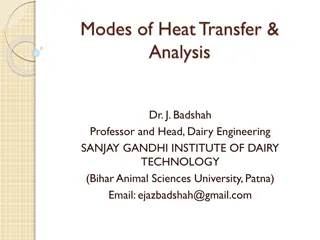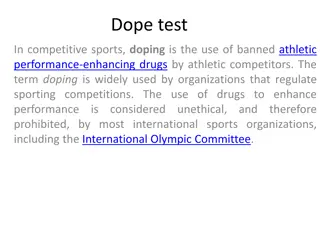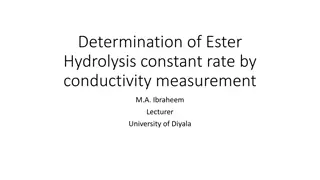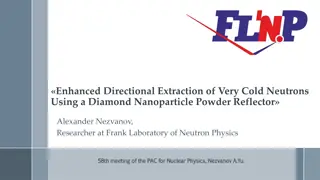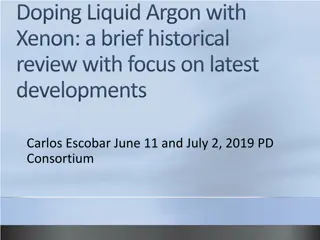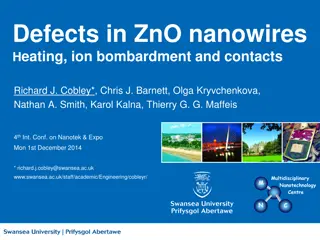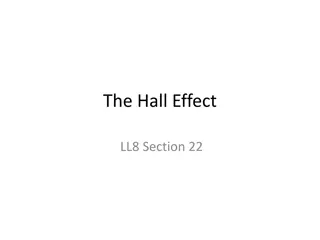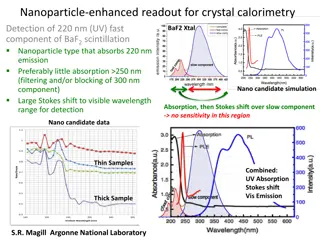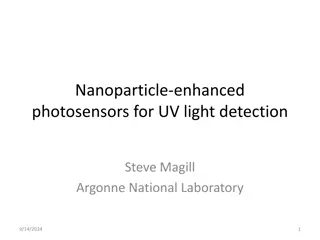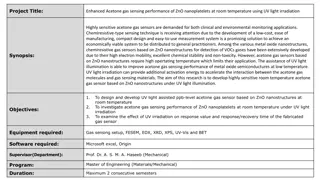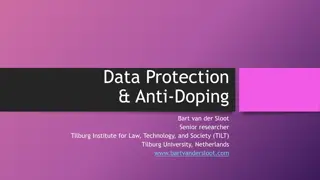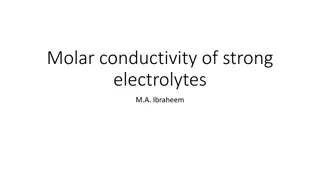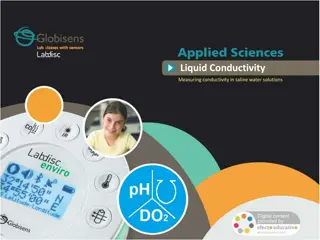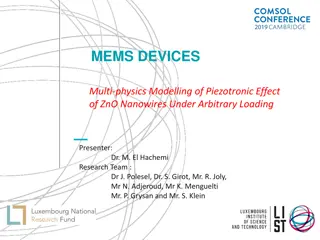Effect of ZnO Nanoparticle Doping on PVC Conductivity
Conducting polymers like ZnO-doped PVC films are explored for their electrical conductivity properties. The ZnO material, a wide band gap semiconductor, is tailored to enhance performance for electronic and photonic applications. This study focuses on the preparation of ZnO-doped PVC films and the impact of nanoparticle doping on conductivity.
Download Presentation

Please find below an Image/Link to download the presentation.
The content on the website is provided AS IS for your information and personal use only. It may not be sold, licensed, or shared on other websites without obtaining consent from the author.If you encounter any issues during the download, it is possible that the publisher has removed the file from their server.
You are allowed to download the files provided on this website for personal or commercial use, subject to the condition that they are used lawfully. All files are the property of their respective owners.
The content on the website is provided AS IS for your information and personal use only. It may not be sold, licensed, or shared on other websites without obtaining consent from the author.
E N D
Presentation Transcript
XIIth Biennial National Conference of Physics Academy of North East (PANE2021),15-17 December, 2021 Effect on the conductivity of ZnO nanoparticle dopped in PVC films A. Joy Singh PRESENTED BY: A. Joy Singh Department of Physics S. Kula Women s College, Nambol, Manipur
XIIth Biennial National Conference of Physics Academy of North East (PANE2021),15-17 December, 2021 INTODUCTION Conducting polymers are organic polymers that conduct electricity; such compound may have metallic conductivity or can be a semiconductor. Conducting polymers are generally not plastic but like insulating polymer, these are organic materials. They can offer high electrical conductivity but do not show mechanical properties as other commercially used polymers do. The electrical properties can be fine-tuned using the method of organic synthesis and by advance dispersion techniques. The most recent research in conducting polymers is to develop high conducting with stability and acceptable processing attributes. So for most well studied conducting polymers are (i) nitrogen containing polymers, i.e Poly(pyrrole)s (PPY), polyanilines (PANI). (ii) Sulfur containing polymers, i.e. Poly(thiophene)s (PT), Poly(3,4 ethylenedioxythiophene) (PEDOT), Poly(P-phenylenesulfide)(PPS) and (iii) other polymers i.e. Poly(acetylene)s
XIIth Biennial National Conference of Physics Academy of North East (PANE2021),15-17 December, 2021 The ZnO material is a wide band gap 3.3 eV (at room temperature) n-type semiconductor. Advantages associated with a large band gap include higher breakdown voltage ability to sustain large electric field, lower electronic noise, high temperature and higher power operation. The band gap of ZnO can further be tuned to 3-4 eV by its alloying magnesium oxide or cadmium oxide. Nanostructured ZnO materials are current importance in electronic, optic and photonic applications and for the basis of nanotechnology applications in sensors and molecular electronics. The nanostructured exhibit novel electrical, mechanical, chemical and optical properties which are believed to be due to the surface confinement effects or nanostructures in one dimension. These one dimensional objects are of great importance in understanding some basic physics related phenomena in the low dimension system to form the basis of next generation higher performance nanodevices.
XIIth Biennial National Conference of Physics Academy of North East (PANE2021),15-17 December, 2021 Material and Method: (i) Sample preparation: PVC granule form supplied by the Reliance industry Surat, Gujarat and cyclohexanon supplied by S D Fine Chem Ltd, Mumbai for the present study form a solution (4 gram of PVC and 20 cc of cyclohexanon). The solution kept at room temperature for one week. For complete dissolution, the solution is poured on the glass plate to make a thin film. The glass plate is placed over a pool of mercury for perfect leveling so as to ensure uniform thickness. The whole system was allowed to evaporate at room temperature in dust free chamber for 6 days and after complete evaporation the film was detached from the glass plate. Thus a pure (PVC + cyclohexanon) PVC film is formed. After a solution is form as above, ZnO nanoparticles supplied by Material Science Laboratory, B N College, Patna, is doped with different quantities i.e. 0.00325 gm/cc, 0.00653gm/cc and 0.01303 gm/cc. Now, the mixture (PVC + ZnO) is stirred by Magnetic stirrer (Eltect-MS 205) for 8 hrs then the mixture is poured on the glass plate and proceeds as above. Thus, the ZnO nanoparticle doped PVC film was formed. The thickness of the sample was measured by screw gauge having least count of 0.01 mm and found to be 0.035 cm, 0.0175 cm, 0.03 cm and 0.019 cm.
Result and discussion: In the present study fig (1 4) are the curves between Ln (mho/m) and1 ? x 10 3 of the virgin and ZnO nanoparticle doped PVC film. The slight increase in the conductivity up to 353 K and sharply increase in the conductivity up to 373 K are observed for all applied voltage (100 V to 1400 V) which shows the nonlinear field dependence in virgin and ZnO nanoparticle doped in PVC film. The electrical conductivity of polymer is largely affected by the presence of free ions which are not associated chemically with the macromolecules. The chemical constituents produce its effect indirectly on the ions mobility. In both virgin and nanoparticle doped PVC films shows the semiconducting nature. So the variation of electrical conductivity with temperature can be represented by the Arrhenious equation, = ???? ?? /? Where ?? = pre exponential factor, ?? = the activation energy of conduction and K = the Boltzmann constant.
-18 -17.9 Fig.3. Plot between (1/T x 10-3) verses Ln( ) for PVC with ZnO nanoparticle doped at 0.0130 gm/cc 2.6 2.8 3 3.2 3.4 2.6 2.8 3 3.2 3.4 -18.4 -18.5 100V 200V 300V 400V 500V 600V 700V 800V 900V 1000V 1100V 1200V 1300V 1400V -18.9 Fig.1. Plot between (1/Tx 10-3) verses Ln for pure PVC -19 -19.4 -19.5 Ln ( ) -19.9 Ln( ) -20 -20.4 100V 200V 300V 400V 500V 600V 700V 800V 900V 1000V 1100V 1200V 1300V -20.9 -20.5 -21.4 -21 -21.9 -21.5 -22.4 -22 -22.9 1/T 1/ T -18.5 -18 2.6 2.8 3 3.2 3.4 -19 2.6 2.8 3 3.2 3.4 -18.5 -19.5 -19 Fig.2 Plot between (1/T x 10-3) verses Ln( ) for PVC with ZnO nanoparticle doped at 0.00653 gm/cc -19.5 Fig.4 Plot between (1/Tx 10-3) verses Ln( ) for PVC with ZnO nanoparticle doped at 0.003265gm/cc -20 -20 -20.5 -20.5 Ln ( ) Ln ( ) -21 -21 100 V 200 V 300 V 400 V 500 V 600 V 700 V 800 V 900 V 1000 V 1100 V 1200 V 1300 V -21.5 100V 200V 300V 400V 500V 600V 700V 800V 900V 1000V 1100V 1200V -21.5 -22 -22 -22.5 -22.5 -23 -23 -23.5 -23.5 1/T -24 1/T
Value of activation energy in eV for different applied voltage for the doped samples
XIIth Biennial National Conference of Physics Academy of North East (PANE2021),15-17 December, 2021 CONCLUSION ZnO has high electron mobility. As temperature increases, mobility of electrons are increase and the mean free path of electrons are decrease. So in ZnO nanoparticle doped PVC film has lower conductivity than the undoped PVC film at higher temperature. This is due to the disturbance of ionic mobility in PVC by electron mobility In such sample electronic current is operative as its activation energy low(<1 eV). So it is concluded that such polymer nanocomposites could be used as good semiconducting materials for many electronic devices.





